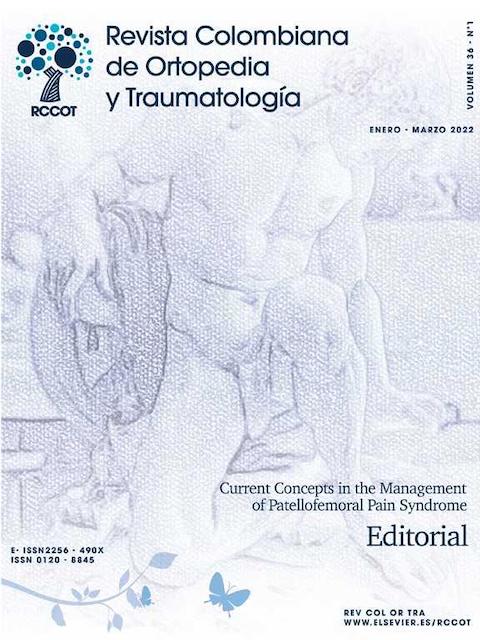Revisión narrativa: unidad de ortogeriatría, la propuesta para reducir los desenlaces adversos en adultos mayores con fracturas de cadera por fragilidad
DOI:
https://doi.org/10.1016/j.rccot.2022.04.010Palabras clave:
fracturas espontáneas, ortogeriatría, complicaciones posoperatorias, fracturas de caderaResumen
Introducción: Las fracturas de cadera son un problema de salud pública debido a su asociación con altas tasas de mortalidad a un año, deterioro funcional y empeoramiento de la calidad de vida. Un enfoque multidisciplinario mejora los resultados de los pacientes adultos mayores con fracturas por fragilidad.
Objetivo: Realizar una revisión narrativa para evaluar la evidencia de las unidades de ortogeriatría como estrategia para reducir desenlaces adversos en adultos mayores con fracturas de cadera por fragilidad.
Materiales y métodos: Se realizó una búsqueda de la literatura en las siguientes bases de datos: PubMed,Cochrane y Scielo, con los términos: "hip fracture" or "fragility fracture" AND "multidisciplinary team" or "Geriatric co management" or AND "orthogeriatric" or "ortho-geriatric".
Resultados: El manejo por ortogeriatría reduce el tiempo de evaluación pre-quirúrgico, complicaciones postoperatorias y la estancia hospitalaria. La valoración interdisciplinaria ha demostrado ser eficaz para disminuir el deterioro funcional, la mortalidad intrahospitalaria, la mortalidad a los 30 días y el riesgo de institucionalización en comparación con otros modelos de atención. Estos factores impactan sobre la optimización de recursos disminuyendo los costos en salud.
Conclusión: Los servicios de ortogeriatría son el modelo ideal para tratar las fracturas de cadera por fragilidad en adultos mayores. En Colombia se deben implementar más unidades de ortogeriatría para mejorar la atención intrahospitalaria, crear programas de seguimiento y rehabilitación.
Descargas
Referencias bibliográficas
Katsoulis M, Benetou V, Karapetyan T, Feskanich D, Grodstein F, Pettersson-Kymmer U, et al. Excess mortality after hip fracture in elderly persons from Europe and the USA: the CHANCES project. J Intern Med. 2017;281:300-10.
Department of Orthopaedics and Traumatology, The Chinese University of Hong Kong, Shatin, Hong Kong, Leung K, Yuen W, Ngai W, Lam C, Lau T, et al. How well are we managing fragility hip fractures? A narrative report on the review with the attempt to setup a Fragility Fracture Registry in Hong Kong. Hong Kong Med J [Internet]. 5 de mayo de 2017 [citado 5 de septiembre de 2021]; Disponible en: http://www.hkmj.org/abstracts/v23n3/264.htm.
Medina Orjuela A, Rosero Olarte Ó, Nel Rueda Plata P, Sánchez Escobar F, Chalem Choueka M, González Reyes MÁ, et al. II Consenso Colombiano para el Manejo de la Osteoporosis Posmenopáusica. Rev Colomb Reumatol. 2018;25:184-210.
Falaschi P, Marsh D, editores. Orthogeriatrics: The Management of Older Patients with Fragility Fractures [Internet]. Cham: Springer International Publishing; 2021 [citado 5 de septiembre de 2021]. (Practical Issues in Geriatrics). Disponible en: http://link.springer.com/10.1007/978-3-030-48126-1.
Downey C, Kelly M, Quinlan JF. Changing trends in the mortality rate at 1-year post hip fracture - a systematic review. World J Orthop. 2019;10:166-75.
Vallejo-González S, Martínez JW, Benítez-Mejía JF, Morales- Cuéllar J, Restrepo-López JS, Arango-Duque JA. Caracterización clínico-epidemiológica de pacientes con fracturas por fragilidad: ¿Estamos haciendo las cosas bien? Acta Médica Colomb. 2020;45(3.), http://dx.doi.org/10.36104/amc.2020.1319.
Rapp K, Becker C, Todd C, Rothenbacher D, Schulz C, König H-H, et al. The Association Between Orthogeriatric Co-Management and Mortality Following Hip Fracture. Dtsch Aerzteblatt Online [Internet]. 24 de Ene de 2020.[citado 5 de septiembre de 2021].
Aletto C, Aicale R, Pezzuti G, Bruno F, Maffulli N. Impact of an orthogeriatrician on length of stay of elderly patient with hip fracture. Osteoporos Int. 2020;31:2161-6.
Dolan MM, Hawkes WG, Zimmerman SI, Morrison RS, Gruber- Baldini AL, Hebel JR, et al. Delirium on Hospital Admission in Aged Hip Fracture Patients: Prediction of Mortality and 2- Year Functional Outcomes. J Gerontol A Biol Sci Med Sci. 2000;55:M527-34.
Caicedo-Correa SM, Aruachan-Torres SA, Segura-Valencia AI, Chavarro-Carvajal DA. Asociación del estado nutricional y funcional en ancianos con fractura de cadera. Acta Médica Colomb. 2019;44:7-10.
Khan MA, Hossain FS, Ahmed I, Muthukumar N, Mohsen A. Predictors of early mortality after hip fracture surgery. Int Orthop. 2013;37:2119-24.
Figved W, Myrstad M, Saltvedt I, Finjarn M, Flaten Odland LM, Frihagen F, Team Approach:. Multidisciplinary Treatment of Hip Fractures in Elderly Patients: Orthogeriatric Care. JBJS Rev. 2019;7:e6, http://dx.doi.org/10.2106/JBJS.RVW.18.00136.
Baroni M, Serra R, Boccardi V, Ercolani S, Zengarini E, Casucci P, et al. The orthogeriatric comanagement improves clinical outcomes of hip fracture in older adults. Osteoporos Int. 2019;30:907-16.
Middleton M. Orthogeriatrics and Hip Fracture Care in the UK: Factors Driving Change to More Integrated Models of Care. Geriatrics. 2018;3:55.
Zamora T, Klaber I, Bengoa F, Botello E, Schweitzer D, Amenábar P. Controversias en el manejo de la fractura de cadera en el adulto mayor. Encuesta nacional a Traumatólogos especialistas en cirugía de cadera. Rev Médica Chile. 2019;147:199-205.
Wilson H. Orthogeriatrics in Hip Fracture. Open Orthop J. 2017;11:1181-9.
Eamer G, Taheri A, Chen SS, Daviduck Q, Chambers T, Shi X, et al. Comprehensive geriatric assessment for older people admitted to a surgical service. Cochrane Effective Practice and Organisation of Care Group, editor. Cochrane Database Syst Rev [Internet]. 2018 [citado 12 de septiembre de 2021]; 2018(3).
Mazzola P, Floris P, Picone D, Anzuini A, Tsiantouli E, Haas J, et al. Functional and clinical outcomes of patients aged younger and older than 85 years after rehabilitation post-hip fracture surgery in a co-managed orthogeriatric unit: Outcomes of hip fracture surgery. Geriatr Gerontol Int. 2018;18:1194-9.
Chow SK-H, Qin J, Wong RM-Y, Yuen W-F, Ngai W-K, Tang N, et al. One-year mortality in displaced intracapsular hip fractures and associated risk: a report of Chinese-based fragility fracture registry. J Orthop Surg. 2018;13:235.
Mears SC, Kates SL. A Guide to Improving the Care of Patients with Fragility Fractures. Edition 2. Geriatr Orthop Surg Rehabil. 2015;6:58-120.
Reguant F, Arnau A, Lorente JV, Maestro L, Bosch J. Efficacy of a multidisciplinary approach on postoperative morbidity and mortality of elderly patients with hip fracture. J Clin Anesth. 2019;53:11-9.
Grigoryan KV, Javedan H, Rudolph JL. Orthogeriatric Care Models and Outcomes in Hip Fracture Patients: A Systematic Review and Meta-Analysis. J Orthop Trauma. 2014;28:e49-55.
Kusen JQ, Schafroth B, Poblete B, van der Vet PCR, Link BC, Wijdicks FJG, et al. The implementation of a Geriatric Fracture Centre for hip fractures to reduce mortality and morbidity: an observational study. Arch Orthop Trauma Surg. 2019;139:1705-12.
Bugaevsky Y, Levy Y, Hershkovitz A, Ocheretny I, Nissenholtz A, Cooper L, et al. Characteristics and Outcomes of Hip Fracture Patients Hospitalized in an Orthogeriatric Unit Versus an Orthopedic Department: A Retrospective Cohort Study. Geriatr Orthop Surg Rehabil. 2021;12, 215145932098629.
Venegas-Sanabria LC, Lozano-Rengifo MJ, Cepeda-Alonso L, Chavarro-Carvajal DA. Complicaciones intrahospitalarias en ancianos con fractura de cadera: estudio transversal para determinar los factores asociados. Rev Colomb Ortop Traumatol. 2018;32:245-50.
Morales Ó, Parra JD, Mateus R. Morbimortalidad posterior a fracturas intertrocantéricas de cadera. Efecto del retraso en el tratamiento quirúrgico. Rev Colomb Ortop Traumatol. 2018;32:33-7.
Tan L, Wong S, Kwek E. Inpatient cost for hip fracture patients managed with an orthogeriatric care model in Singapore. Singapore Med J. 2017;58:139-44.
Rocca GJD, Moylan KC, Crist BD, Volgas DA, Stannard JP, Mehr DR. Comanagement of Geriatric Patients With Hip Fractures: A Retrospective, Controlled. Cohort Study. Geriatr Orthop Surg Rehabil. 2013;4:10-5.









